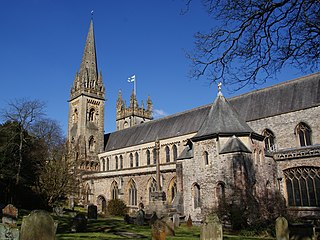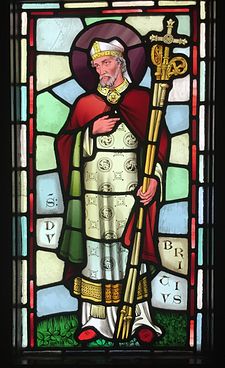
Llandaff Cathedral is an Anglican cathedral and parish church in Llandaff, Cardiff, Wales. It is the seat of the Bishop of Llandaff, head of the Church in Wales Diocese of Llandaff. It is dedicated to Saint Peter and Saint Paul, and three Welsh saints: Dubricius, Teilo and Oudoceus. It is one of two cathedrals in Cardiff, the other being the Roman Catholic Cardiff Metropolitan Cathedral in the city centre.

Samson of Dol was a Welsh saint, who is also counted among the seven founder saints of Brittany with Pol Aurelian, Tugdual or Tudwal, Brieuc, Malo, Patern (Paternus) and Corentin. Born in southern Wales, he died in Dol-de-Bretagne, a small town in north Brittany.

Saint Deiniol was traditionally the first Bishop of Bangor in the Kingdom of Gwynedd, Wales. The present Bangor Cathedral, dedicated to Deiniol, is said to be on the site where his monastery stood. He is venerated in Brittany as Saint Denoual. In English and Latin his name is sometimes rendered as Daniel.

Llanddewi Brefi is a village, parish and community of approximately 500 people in Ceredigion, Wales. The village is notable for the famous Synod of Brefi held here in the sixth century. A number of miraculous events are said to have occurred during the synod, most notably by Saint David Welsh: Dewi Sant, patron saint of Wales. Today, it is one of the largest parishes in Wales and lies 7 miles (11 km) north-east of Lampeter between Tregaron and Llanfair Clydogau.

Archenfield is the historic English name for an area of southern and western Herefordshire in England. Since the Anglo-Saxons took over the region in the 8th century, it has stretched between the River Monnow and River Wye, but it derives from the once much larger Welsh kingdom of Ergyng.

The Diocese of Llandaff is an Anglican diocese that traces its roots to pre-Reformation times as heir of a Catholic bishopric. It is headed by the Bishop of Llandaff, whose seat is located at the Cathedral Church of Saint Peter and Saint Paul in Llandaff, a suburb of Cardiff. It currently covers most of the former Welsh county of Glamorgan, but once stretched from the River Towy to the middle of the Wye Valley.

The Bishop of Llandaff is the ordinary of the Church in Wales Diocese of Llandaff.

Llanvaches or Llanfaches is a village and community parish within the boundaries of the city of Newport, Wales. It lies to the east of the urban area, in the historic county of Monmouthshire and the preserved county of Gwent. The population rose to 402 by the 2011 census.

Ergyng was a Welsh kingdom of the sub-Roman and early medieval period, between the 5th and 7th centuries. It was later referred to by the English as Archenfield.
The Synod of Brefi was a church council held at Llanddewi Brefi in Ceredigion, Wales, around 545.
Urban was the first bishop of South East Wales to call himself 'bishop of Llandaff'. He was of a Welsh clerical family and his baptismal name in the Welsh language is given in charter sources as Gwrgan. He Latinised it to the papal name 'Urban'.
Peibo Clafrog, was King of Ergyng in south-east Wales in the 5th or 6th century. He is chiefly known from the legends of Saint Dubricius, who was supposedly his grandson. The contemporary rendering of this name would seem to be Peibio, as in Garthbeibio, a parish in Montgomeryshire, or Ynys Beibio, near Holyhead.
There is archaeological evidence of insular monasticism as early as the mid 5th century, influenced by establishments in Gaul such as the monastery of Martin of Tours at Marmoutier, the abbey established by Honoratus at Lérins; the abbey of Mont-Saint-Michel; and that of Germanus at Auxerre. Many Irish monks studied at Candida Casa near Whithorn in what is now Galloway in Scotland.
Devereux is a Norman surname found frequently in Ireland, Wales, England and around the English-speaking world. Saint Devereux Church in Hereford, United Kingdom is also named Saint Dubricius and is dedicated to the 6th century clergyman Saint Dubricius from Hereford, suggesting that the name is a Norman French rendering of Dubricius or the saint's Welsh name Dyfrig. In Ireland, the name is associated with Wexford, where the Cambro-Normans first invaded from Pembrokeshire, Wales in 1170. Devereux is more probably the Anglo-Norman form of D'Evreux / Devreux, meaning d'Évreux. Anglo-Norman develops regularly a svarabakhti vowel /e/ between /v/ and /r/, such as in overi, or livere. Dubricius is called Dubrice in French and Dyfrig would have given *Difry / *Dufry in French and *Difery / *Dufery in Anglo-Norman, and St. Devereux is probably a mistranslation after the surname Devereux. The French variant is Devreux, which unlike Devereux is found within Normandy and France themselves.

The Church of St Dubricius in Porlock, Somerset, England dates from the 13th century. The church has been designated by English Heritage as a Grade I listed building.

Saint Teilo, also known by his Cornish name Eliud, was a British Christian monk, bishop, and founder of monasteries and churches. He was from Penalun (Penally) near Tenby in Pembrokeshire, south Wales.
Inabwy was a Welsh bishop and saint who lived in the sixth and seventh century.
Clydog was a sixth-century Welsh king of Ergyng who became a saint. His feast day is traditionally held on 3 November but is also celebrated on 19 August.

St Dyfrig's Church is a listed Roman Catholic church in the village of Treforest near Pontypridd, South Wales. The church was founded in the 19th century, though the present structure dates from the 1920s.











